
partcad
Package manager for things. Start designing modular hardware! PartCAD is the standard for documenting manufacturable physical products (a.k.a. Digital Thread or TDP). It comes with a set of tools to maintain product information and to facilitate efficient and effective workflows at all product lifecycle phases, boosted by AI.
Stars: 289
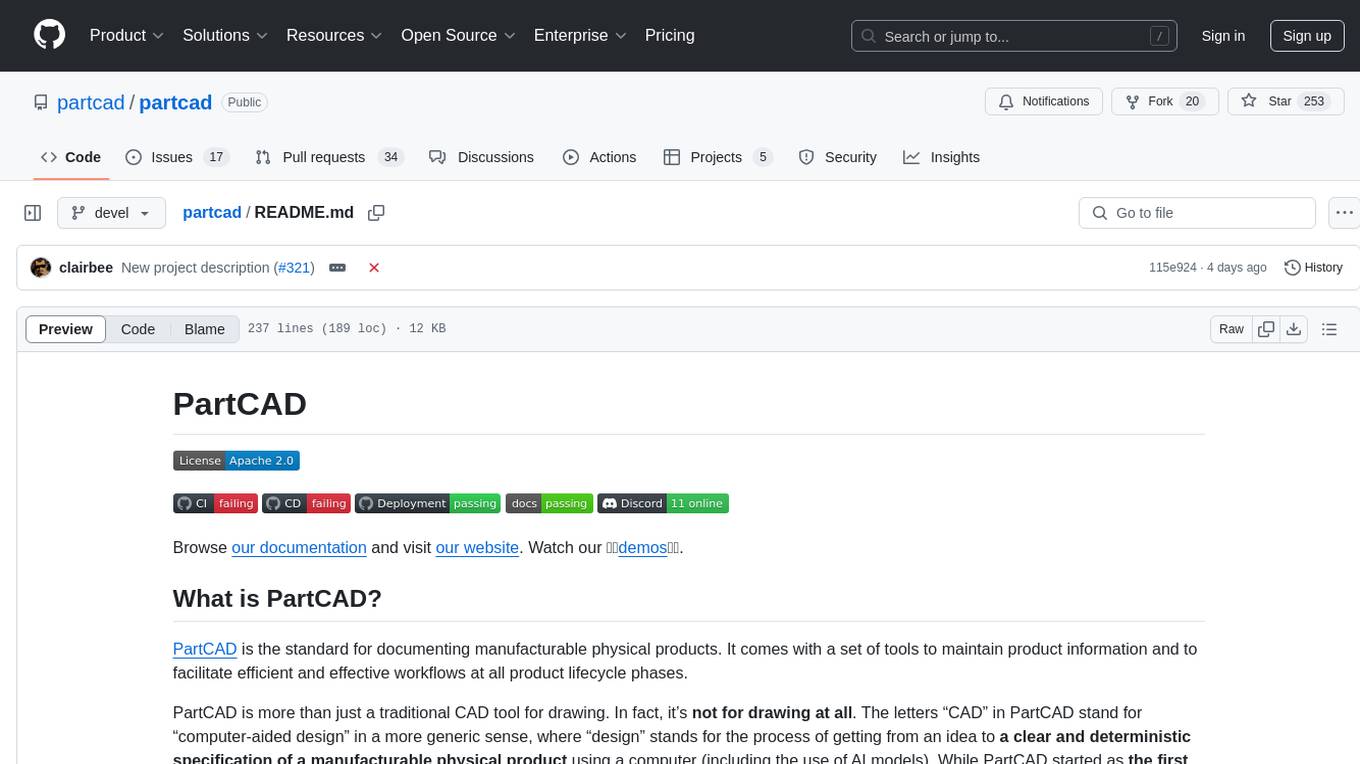
PartCAD is a tool for documenting manufacturable physical products, providing tools to maintain product information and streamline workflows at all product lifecycle phases. It is a next-generation CAD tool that focuses on specifying manufacturable physical products using computer-aided design in a more generic sense, including the use of AI models. PartCAD offers modular and reusable packages for product information, generating outputs like product documentation, bill of materials, sourcing information, and manufacturing process specifications. It integrates with third-party tools for iterative improvements, design validation, and manufacturing processes verification. PartCAD also offers supplementary products like a CRM and inventory tool for managing part manufacturing and assembly shops. By enabling easy switching between third-party tools, PartCAD creates a competitive environment for service providers and ensures data sovereignty for users.
README:
Browse our documentation and visit our website. Watch our 💥💥demos💥💥.
PartCAD is the standard for documenting manufacturable physical products. It comes with a set of tools to maintain product information and to facilitate efficient and effective workflows at all product lifecycle phases.
PartCAD is more than just a traditional CAD tool for drawing. In fact, it’s not for drawing at all. The letters “CAD” in PartCAD stand for “computer-aided design” in a more generic sense, where “design” stands for the process of getting from an idea to a clear and deterministic specification of a manufacturable physical product using a computer (including the use of AI models). While PartCAD started as the first package manager for hardware, it is now the next-generation CAD that can turn a single visionary individual into a one person corporation, or make one future Product Manager as productive (and much faster!) as 10 corporate engineering departments of the past.
PartCAD is constantly evolving, with new features and integrations being added all the time. Contact us to discuss how PartCAD can revolutionize your product development process.
PartCAD includes tools to package product information:
-
Optional (but highly recommended) high-level requirements (texts and drawings)
-
Optional detailed design (mechanical outline, PCB schematics, software architecture)
-
Implementation (mechanical CAD files, PCB layout, software artifacts)
-
Optionally, the following data can be provided to augment or complement the output:
- Additional manufacturing process requirements and instructions
- Additional product validation instructions
- Maintenance instructions
-
Or any other product related metadata
Such packages are modular and reusable, allowing one to build not only on top of the CAD files of previous products, but to build on top of their manufacturing processes as well.
As a result of maintaining the product information using PartCAD, the following outputs can be generated and, if necessary, collected and managed using PartCAD tools:
- Product documentation (markdown, html or PDF)
- Design validation results
- Product bill of materials (mechanical, electronics, software)
- Sourcing information for all components
- Manufacturing process specification (including required equipment if any)
- Manufacturing instructions (sufficiently documented to be reproduced by anyone without inquiring any additional information)
- Product validation instructions
- Product validation results (given access to an experimental product and the required tools)
- Input data for software components to visualize the product on your website, with a 3D viewer, a configurator, manufacturing/assembly instructions and more
Once product information is packaged, it can be versioned and used for iterative improvements or to produce PartCAD outputs either by human or AI actors. To achieve that, PartCAD integrates with third-party tools. Below are just some examples of what third-party integrations can be used for:
- AI tools can be used to update the mechanical design and implementation automatically based on the current state of the requirements
- A legacy CAD tool can be used manually to update the implementation
- AI tools can be used to validate the design and implementation to identify product requirement or best practices (e.g. to reduce manufacturing complexity) violations
- A web interface of an online store or an API of an additive manufacturer can be used to source and manufacture parts
- Simulation tools (potentially in conjunction with AI tools) can be used to validate that the product design matches the product requirements
- AI tools can be used to review the product implementation for correctness, safety or compliance
- Manufacturing processes are verified for completeness (e.g. tools requirements are specified for all operations)
- Manufacturing instructions are verified for correctness (e.g. the provided manufacturing steps can actually be successfully and safely performed, and fit within the capabilities of the selected manufacturing tools)
Some of the iterative improvements or tests can be achieved using PartCAD built-in features. However, the use of third-party tools is recommended for unlocking cutting edge innovations and features.
PartCAD also works on the following supplementary products to enable (if needed) operations without any use of third-party tools:
- A CRM for part manufacturing and assembly shops for businesses of any size (from skilled individuals working in their garage to the biggest factories) to immediately start taking orders for manufacturable products maintained using PartCAD
- An inventory tool to manage the list of parts and final products in stock, as well as to track and manage all in-progress or completed orders, to immediately bring supply chains up and to scale them up while keeping all data private on-prem and not incurring any costs (for cloud services and alike)
By letting the user easily switch between third-party engineering tools or manufacturers without having to migrate product data, PartCAD creates a competitive environment for service providers to drive the costs down.
Whenever you select third-party tools (if any) to use in your workflows, you ultimately decide (and make it transparent or auditable) how secure your supply chain is and how exposed your product information is. If you opt for on-prem tools only, all your product information remains on-prem too. It makes PartCAD an ultimate solution for achieving data sovereignty for those willing to keep their product data private. In the age of cloud data harvesting (especially for AI training), it makes PartCAD a better alternative to any cloud-based PDM, PLM or BOM solution.
Stay informed and share feedback by joining our Discord server.
Subscribe on LinkedIn, YouTube, TikTok, Facebook, Instagram, Threads and Twitter/X.
- Multiple OSes supported
- [x] Windows
- [x] Linux
- [x] macOS
- Workflow acceleration by caching rendered models (including OpenSCAD, CadQuery and build123d)
- [x] In memory
- [x] On disk
- [ ] Local Server (in progress)
- [ ] Cloud (in progress)
- Collaboration on designs
- [x] Versioning of CAD designs using
Git(like it's 2025 for real)- [x] Mechanical
- [x] Electronics
- [ ] Software (in progress)
- [x] Automated generation of
Markdowndocumentation - [x] Parametric (hardware and software) bill of materials
- [x] Publish models online on PartCAD.org
- [ ] Publish models online on your website (in progress)
- [ ] Publish configurable parts and assemblies online (in progress)
- [ ] Purchase of assemblies and parts online, both marketplace and SaaS (in progress)
- [x] Automated purchase of parts via CLI
- [x] Versioning of CAD designs using
- Assembly models (3D)
- [x] Using specialized
Assembly YAMLformat- [x] Automatically maintaining the bill of materials
- [ ] Generating user-friendly visual assembly instructions (in progress)
- [ ] Generating with LLM/GenAI (in progress)
- [x] Using specialized
- Part models (3D)
- Using scripting languages
- Using legacy CAD files
- [x]
STEP - [x]
BREP - [x]
STL - [x]
3MF - [x]
OBJ
- [x]
- Using file formats of third-party tools
- [x]
KiCad EDA(PCB)
- [x]
- Generating with LLM/GenAI
- [x] Google AI (
Gemini) - [x] OpenAI (
ChatGPT) - [x] Any model in Ollama (
Llama 3.1,DeepSeek-Coder-V2,CodeGemma,Code Llamaetc.)
- [x] Google AI (
- Part and interface blueprints (2D)
- Other features
- Object-Oriented Programming approach to maintaining part interfaces and mating information
- Live preview of 3D models while working in Visual Studio Code
- Render 2D and 3D to images
- [x]
SVG - [x]
PNG
- [x]
- Export 3D models to CAD files
- [x]
STEP - [x]
BREP - [x]
STL - [x]
3MF - [x]
ThreeJS - [x]
OBJ
- [x]
Note, it's not required but highly recommended that you have conda installed. If you experience any difficulty installing or using any PartCAD tool, then make sure to install conda.
This extension can be installed by searching for PartCAD in the VS Code extension search form, or by browsing
its VS Code marketplace page.
Make sure to have Python configured and a conda environment set up in VS Code before using PartCAD.
The recommended method to install PartCAD CLI tools for most users is:
pip install -U partcad-cli- On Windows, install
Miniforge3usingRegister Miniforge3 as my default Python X.XXand use this Python environment for PartCAD. Also setLongPathsEnabledto 1 atHKEY_LOCAL_MACHINE\SYSTEM\CurrentControlSet\Control\FileSystemusingRegistry Editor. - On Ubuntu, try
apt install libcairo2-dev python3-devifpip installfails to installcairo. - On macOS, make sure XCode and command lines tools are installed. Also, use
mambashould you experience difficulties on macOS with the ARM architecture.
Refer to the Quick Start guide for step-by-step instructions on setting up your development environment, adding features, and running tests.
See the tutorials for PartCAD command line tools or PartCAD Visual Studio Code extension.
Give us a star for our hard work!
For Tasks:
Click tags to check more tools for each tasksFor Jobs:
Alternative AI tools for partcad
Similar Open Source Tools

partcad
PartCAD is a tool for documenting manufacturable physical products, providing tools to maintain product information and streamline workflows at all product lifecycle phases. It is a next-generation CAD tool that focuses on specifying manufacturable physical products using computer-aided design in a more generic sense, including the use of AI models. PartCAD offers modular and reusable packages for product information, generating outputs like product documentation, bill of materials, sourcing information, and manufacturing process specifications. It integrates with third-party tools for iterative improvements, design validation, and manufacturing processes verification. PartCAD also offers supplementary products like a CRM and inventory tool for managing part manufacturing and assembly shops. By enabling easy switching between third-party tools, PartCAD creates a competitive environment for service providers and ensures data sovereignty for users.
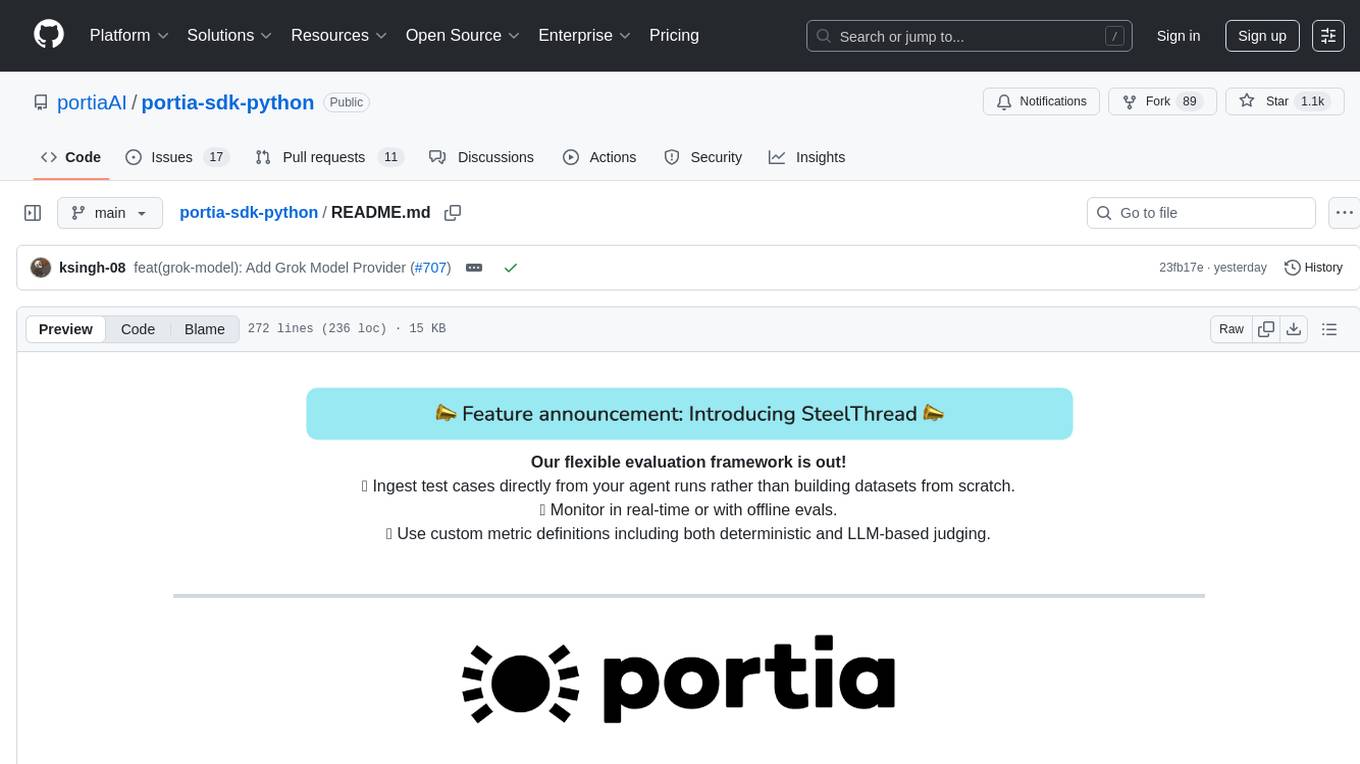
portia-sdk-python
Portia AI is an open source developer framework for predictable, stateful, authenticated agentic workflows. It allows developers to have oversight over their multi-agent deployments and focuses on production readiness. The framework supports iterating on agents' reasoning, extensive tool support including MCP support, authentication for API and web agents, and is production-ready with features like attribute multi-agent runs, large inputs and outputs storage, and connecting any LLM. Portia AI aims to provide a flexible and reliable platform for developing AI agents with tools, authentication, and smart control.
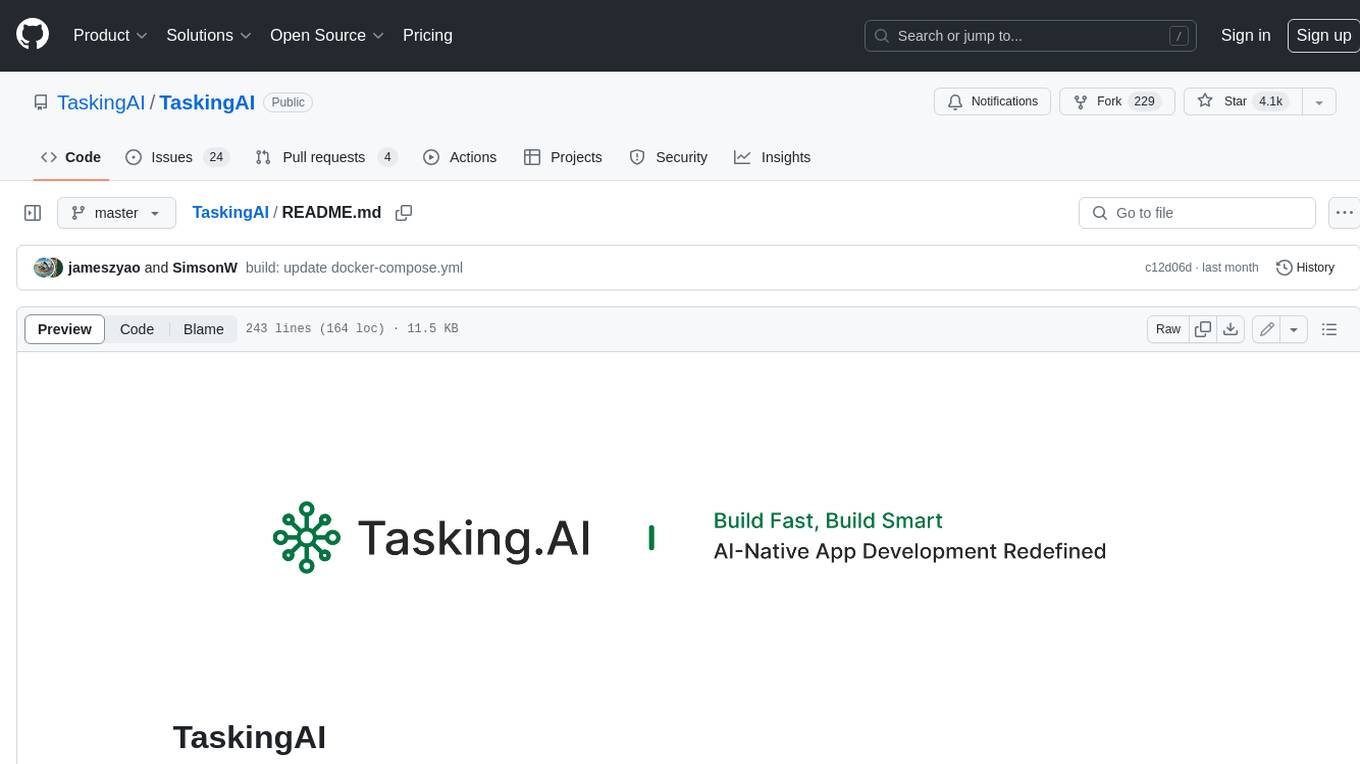
TaskingAI
TaskingAI brings Firebase's simplicity to **AI-native app development**. The platform enables the creation of GPTs-like multi-tenant applications using a wide range of LLMs from various providers. It features distinct, modular functions such as Inference, Retrieval, Assistant, and Tool, seamlessly integrated to enhance the development process. TaskingAI’s cohesive design ensures an efficient, intelligent, and user-friendly experience in AI application development.

opencompass
OpenCompass is a one-stop platform for large model evaluation, aiming to provide a fair, open, and reproducible benchmark for large model evaluation. Its main features include: * Comprehensive support for models and datasets: Pre-support for 20+ HuggingFace and API models, a model evaluation scheme of 70+ datasets with about 400,000 questions, comprehensively evaluating the capabilities of the models in five dimensions. * Efficient distributed evaluation: One line command to implement task division and distributed evaluation, completing the full evaluation of billion-scale models in just a few hours. * Diversified evaluation paradigms: Support for zero-shot, few-shot, and chain-of-thought evaluations, combined with standard or dialogue-type prompt templates, to easily stimulate the maximum performance of various models. * Modular design with high extensibility: Want to add new models or datasets, customize an advanced task division strategy, or even support a new cluster management system? Everything about OpenCompass can be easily expanded! * Experiment management and reporting mechanism: Use config files to fully record each experiment, and support real-time reporting of results.
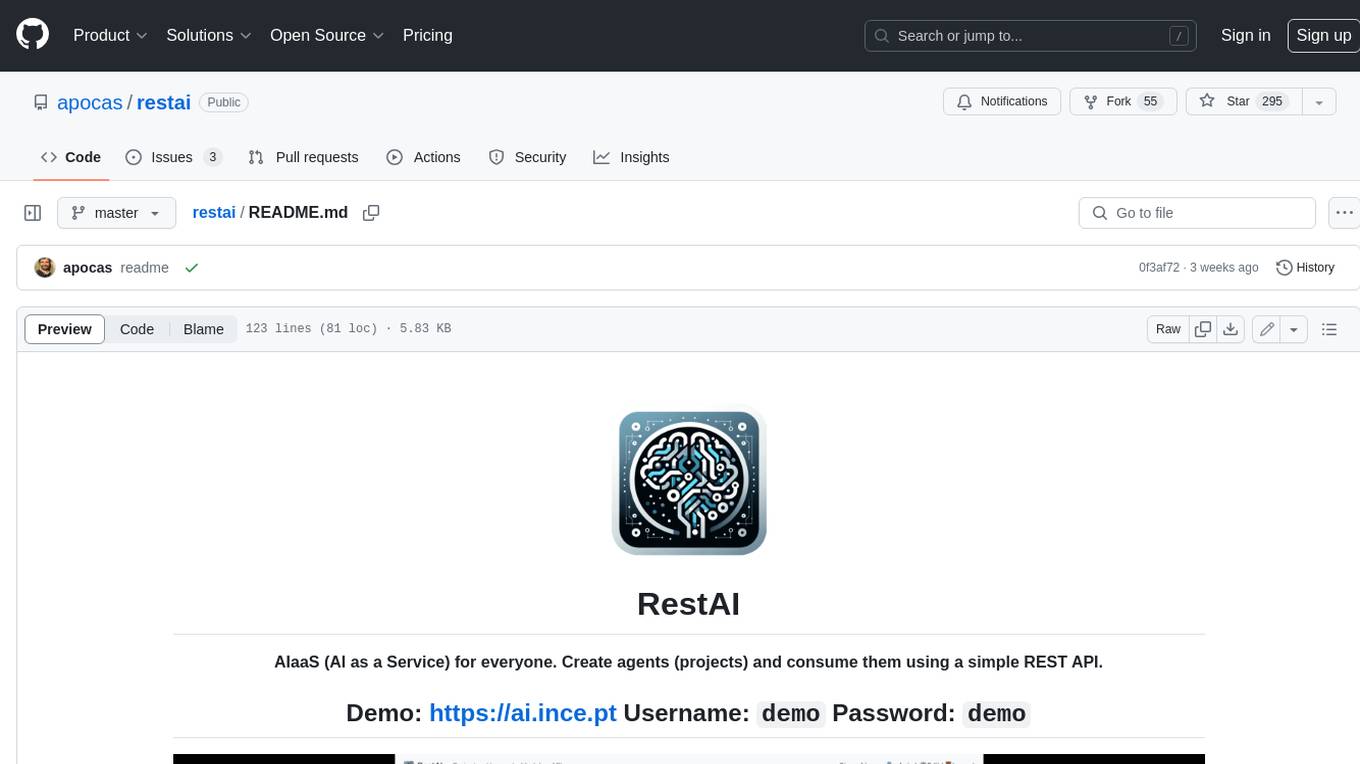
restai
RestAI is an AIaaS (AI as a Service) platform that allows users to create and consume AI agents (projects) using a simple REST API. It supports various types of agents, including RAG (Retrieval-Augmented Generation), RAGSQL (RAG for SQL), inference, vision, and router. RestAI features automatic VRAM management, support for any public LLM supported by LlamaIndex or any local LLM supported by Ollama, a user-friendly API with Swagger documentation, and a frontend for easy access. It also provides evaluation capabilities for RAG agents using deepeval.
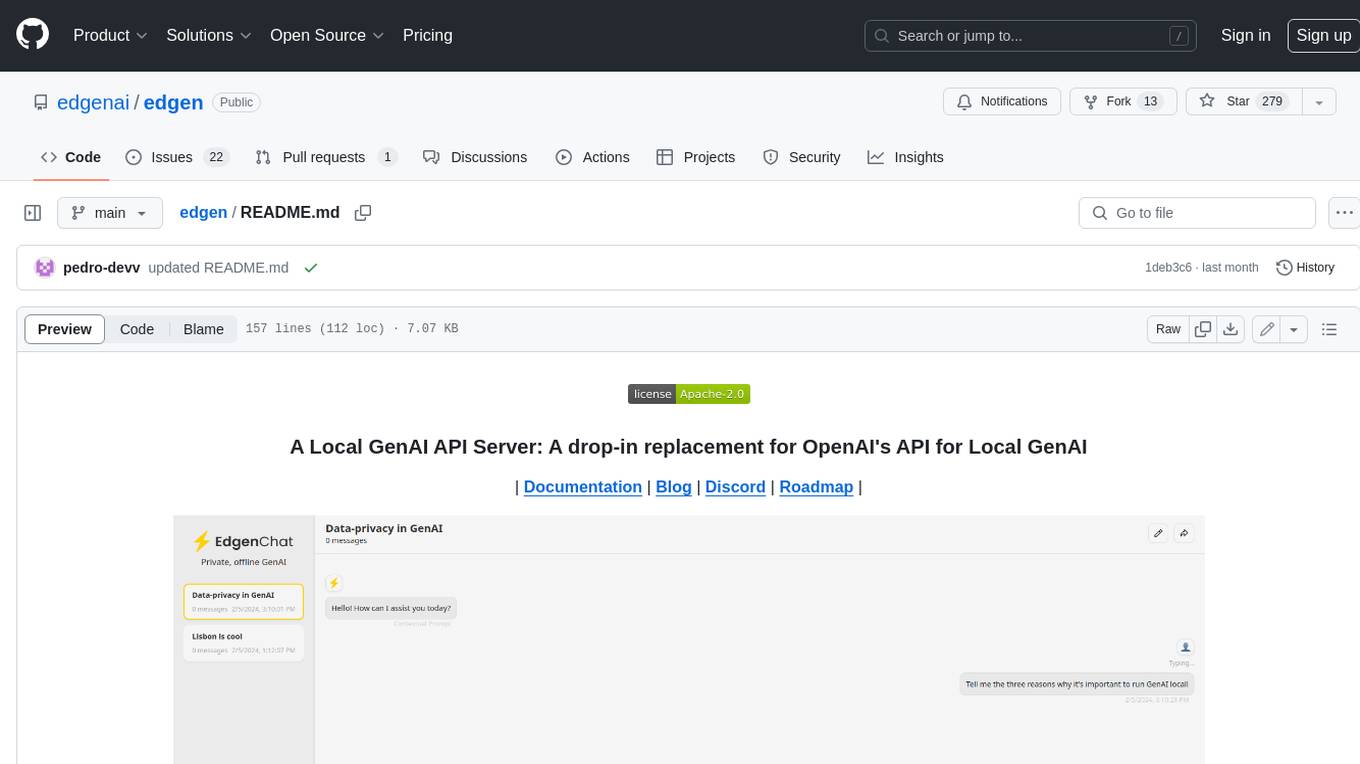
edgen
Edgen is a local GenAI API server that serves as a drop-in replacement for OpenAI's API. It provides multi-endpoint support for chat completions and speech-to-text, is model agnostic, offers optimized inference, and features model caching. Built in Rust, Edgen is natively compiled for Windows, MacOS, and Linux, eliminating the need for Docker. It allows users to utilize GenAI locally on their devices for free and with data privacy. With features like session caching, GPU support, and support for various endpoints, Edgen offers a scalable, reliable, and cost-effective solution for running GenAI applications locally.
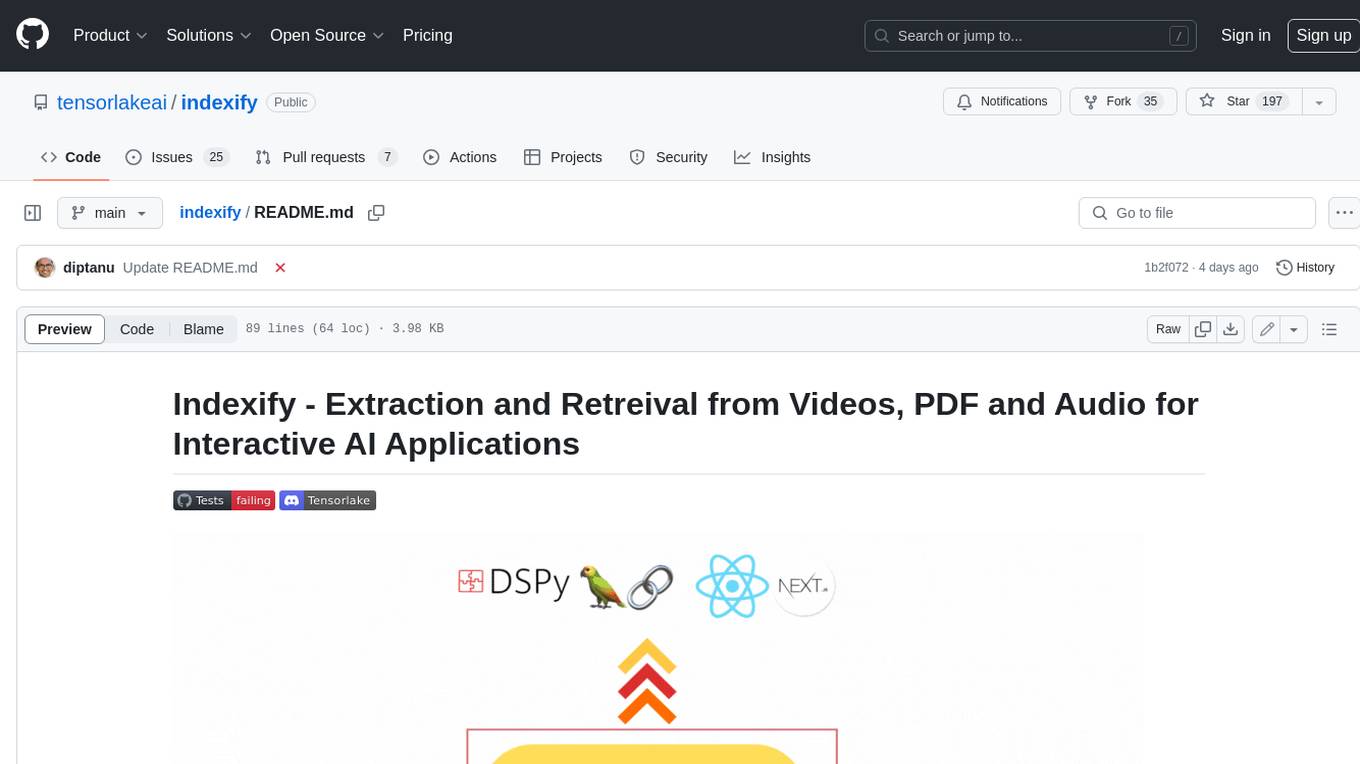
indexify
Indexify is an open-source engine for building fast data pipelines for unstructured data (video, audio, images, and documents) using reusable extractors for embedding, transformation, and feature extraction. LLM Applications can query transformed content friendly to LLMs by semantic search and SQL queries. Indexify keeps vector databases and structured databases (PostgreSQL) updated by automatically invoking the pipelines as new data is ingested into the system from external data sources. **Why use Indexify** * Makes Unstructured Data **Queryable** with **SQL** and **Semantic Search** * **Real-Time** Extraction Engine to keep indexes **automatically** updated as new data is ingested. * Create **Extraction Graph** to describe **data transformation** and extraction of **embedding** and **structured extraction**. * **Incremental Extraction** and **Selective Deletion** when content is deleted or updated. * **Extractor SDK** allows adding new extraction capabilities, and many readily available extractors for **PDF**, **Image**, and **Video** indexing and extraction. * Works with **any LLM Framework** including **Langchain**, **DSPy**, etc. * Runs on your laptop during **prototyping** and also scales to **1000s of machines** on the cloud. * Works with many **Blob Stores**, **Vector Stores**, and **Structured Databases** * We have even **Open Sourced Automation** to deploy to Kubernetes in production.

chatnio
Chat Nio is a next-generation AI one-stop solution that provides a rich and user-friendly interface for interacting with various AI models. It offers features such as AI chat conversation, rich format compatibility, markdown support, message menu support, multi-platform adaptation, dialogue memory, full-model file parsing, full-model DuckDuckGo online search, full-screen large text editing, model marketplace, preset support, site announcements, preference settings, internationalization support, and a rich admin system. Chat Nio also boasts a powerful channel management system that utilizes a self-developed channel distribution algorithm, supports multi-channel management, is compatible with multiple formats, allows for custom models, supports channel retries, enables balanced load within the same channel, and provides channel model mapping and user grouping. Additionally, Chat Nio offers forwarding API services that are compatible with multiple formats in the OpenAI universal format and support multiple model compatible layers. It also provides a custom build and install option for highly customizable deployments. Chat Nio is an open-source project licensed under the Apache License 2.0 and welcomes contributions from the community.
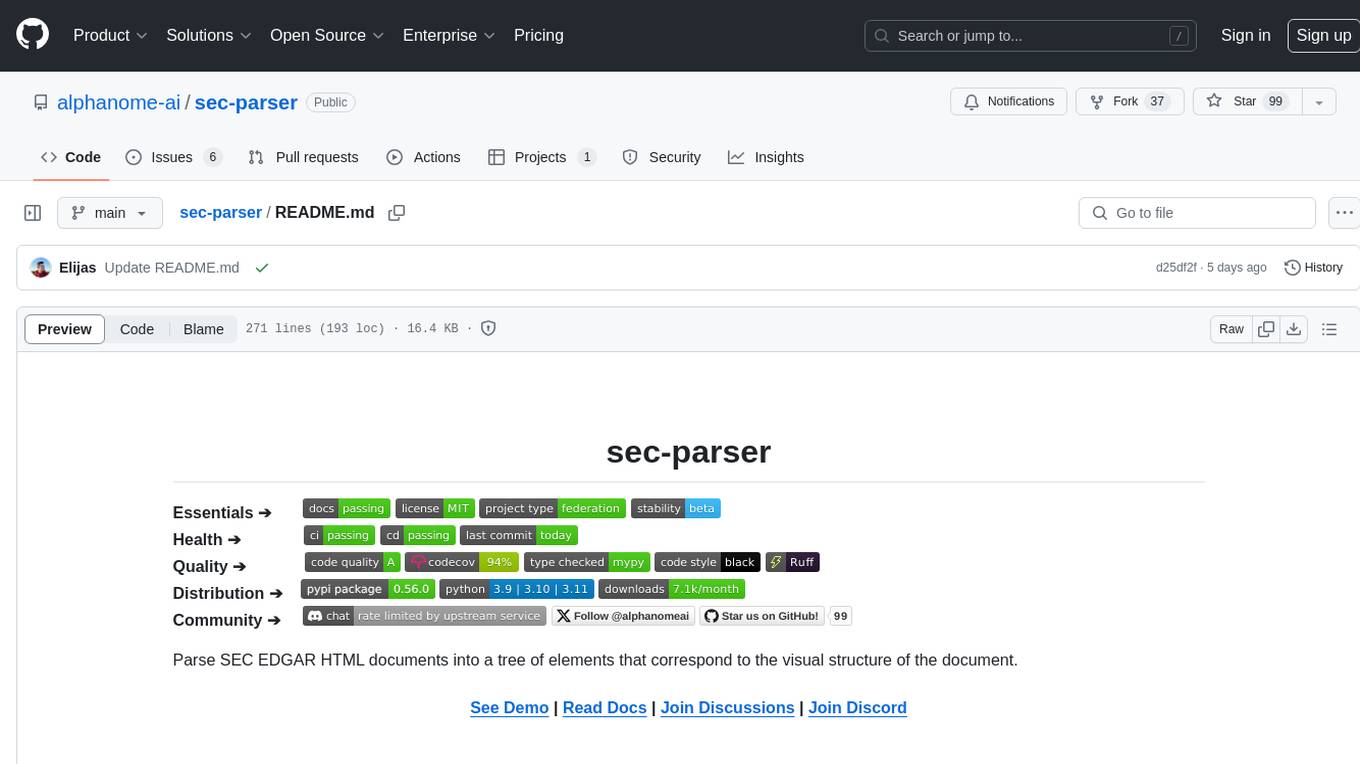
sec-parser
The `sec-parser` project simplifies extracting meaningful information from SEC EDGAR HTML documents by organizing them into semantic elements and a tree structure. It helps in parsing SEC filings for financial and regulatory analysis, analytics and data science, AI and machine learning, causal AI, and large language models. The tool is especially beneficial for AI, ML, and LLM applications by streamlining data pre-processing and feature extraction.
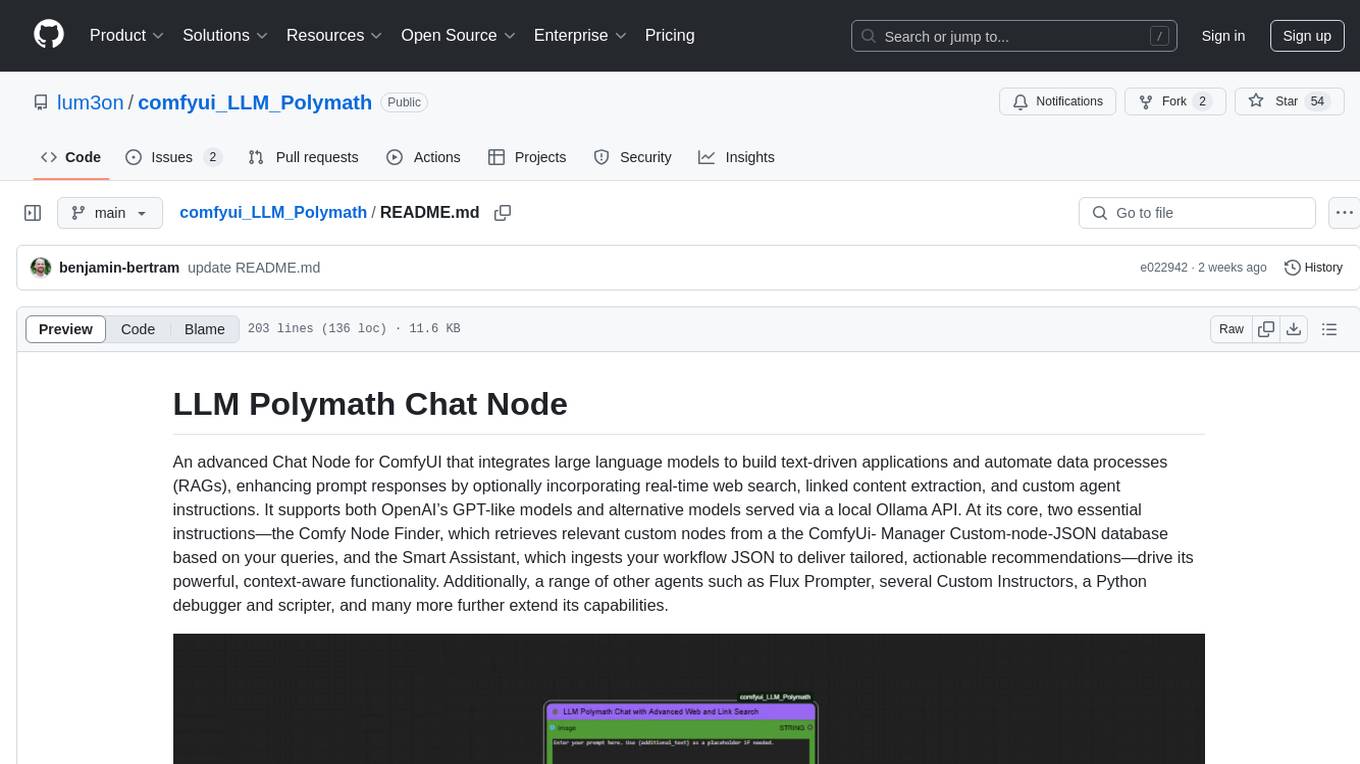
comfyui_LLM_Polymath
LLM Polymath Chat Node is an advanced Chat Node for ComfyUI that integrates large language models to build text-driven applications and automate data processes, enhancing prompt responses by incorporating real-time web search, linked content extraction, and custom agent instructions. It supports both OpenAI’s GPT-like models and alternative models served via a local Ollama API. The core functionalities include Comfy Node Finder and Smart Assistant, along with additional agents like Flux Prompter, Custom Instructors, Python debugger, and scripter. The tool offers features for prompt processing, web search integration, model & API integration, custom instructions, image handling, logging & debugging, output compression, and more.
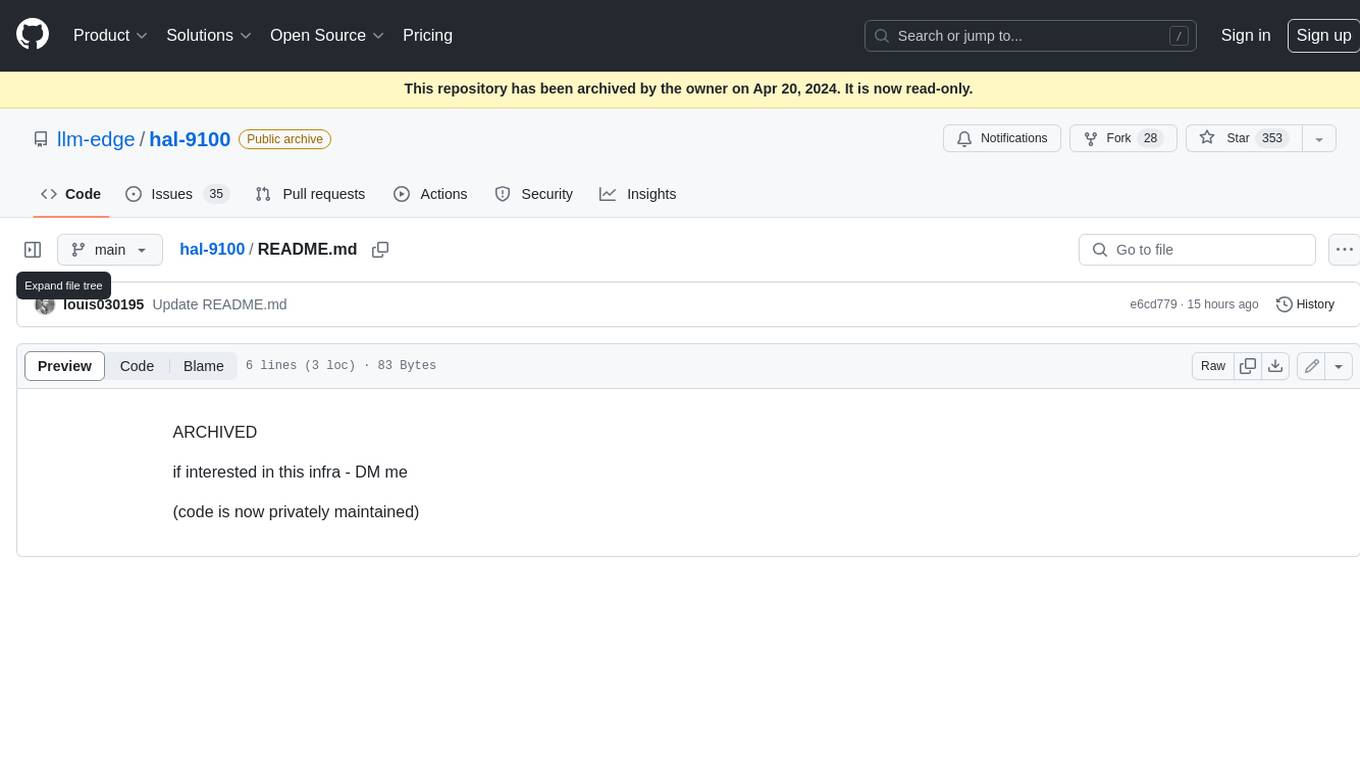
hal-9100
This repository is now archived and the code is privately maintained. If you are interested in this infrastructure, please contact the maintainer directly.
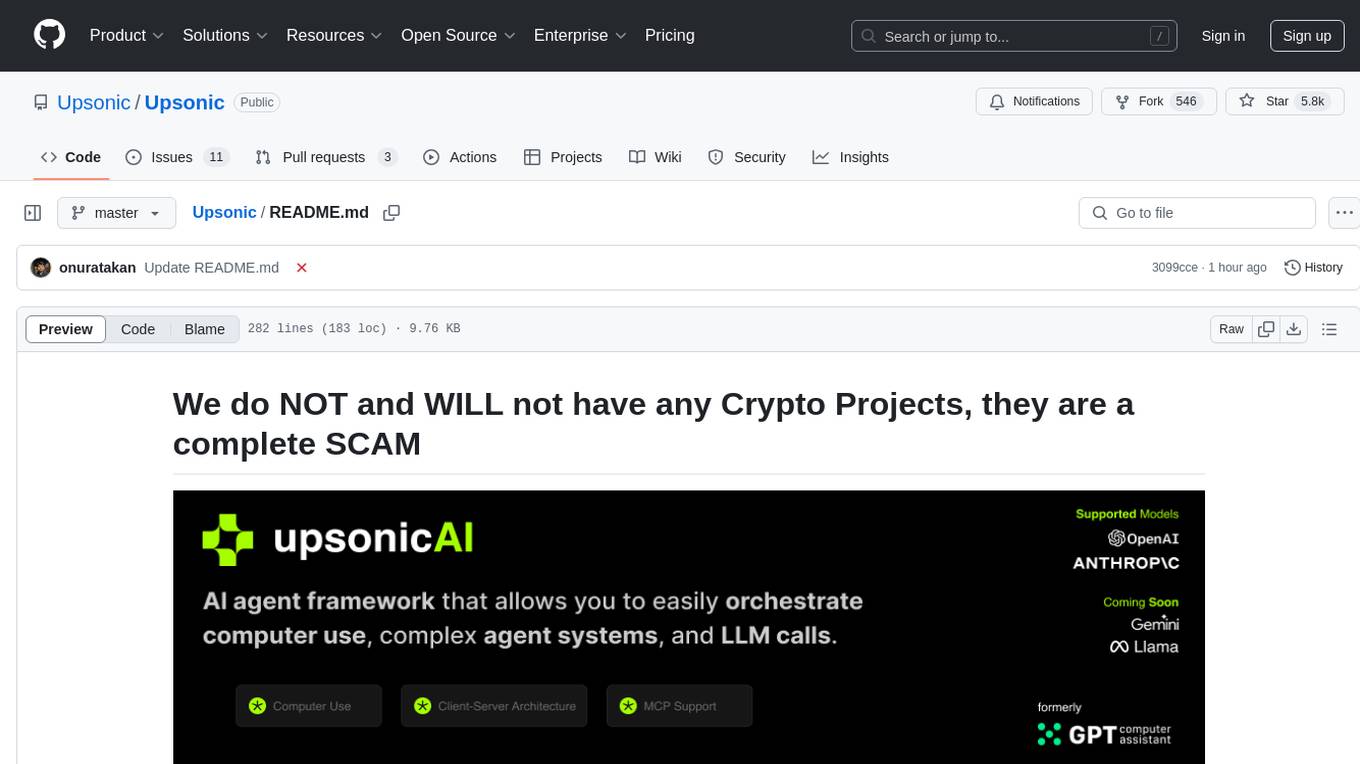
Upsonic
Upsonic offers a cutting-edge enterprise-ready framework for orchestrating LLM calls, agents, and computer use to complete tasks cost-effectively. It provides reliable systems, scalability, and a task-oriented structure for real-world cases. Key features include production-ready scalability, task-centric design, MCP server support, tool-calling server, computer use integration, and easy addition of custom tools. The framework supports client-server architecture and allows seamless deployment on AWS, GCP, or locally using Docker.
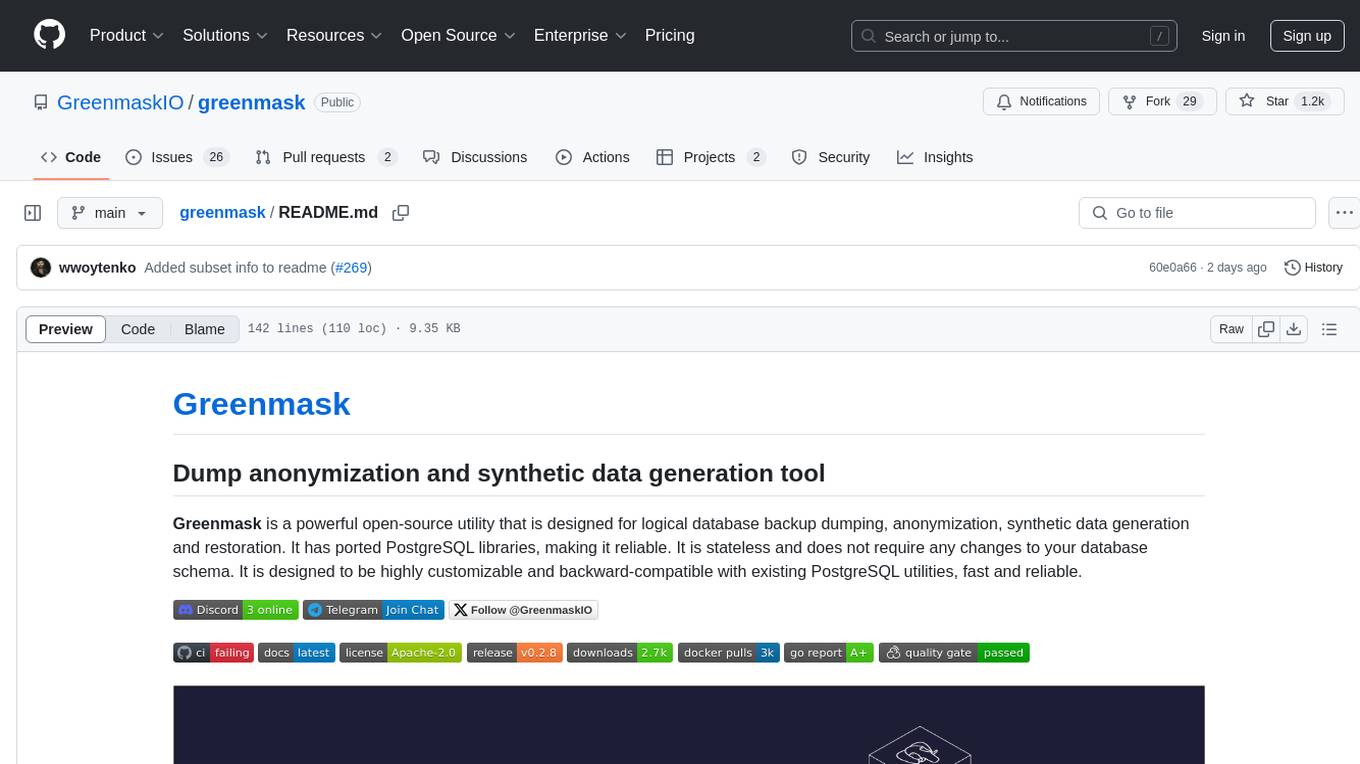
greenmask
Greenmask is a powerful open-source utility designed for logical database backup dumping, anonymization, synthetic data generation, and restoration. It is highly customizable, stateless, and backward-compatible with existing PostgreSQL utilities. Greenmask supports advanced subset systems, deterministic transformers, dynamic parameters, transformation conditions, and more. It is cross-platform, database type safe, extensible, and supports parallel execution and various storage options. Ideal for backup and restoration tasks, anonymization, transformation, and data masking.
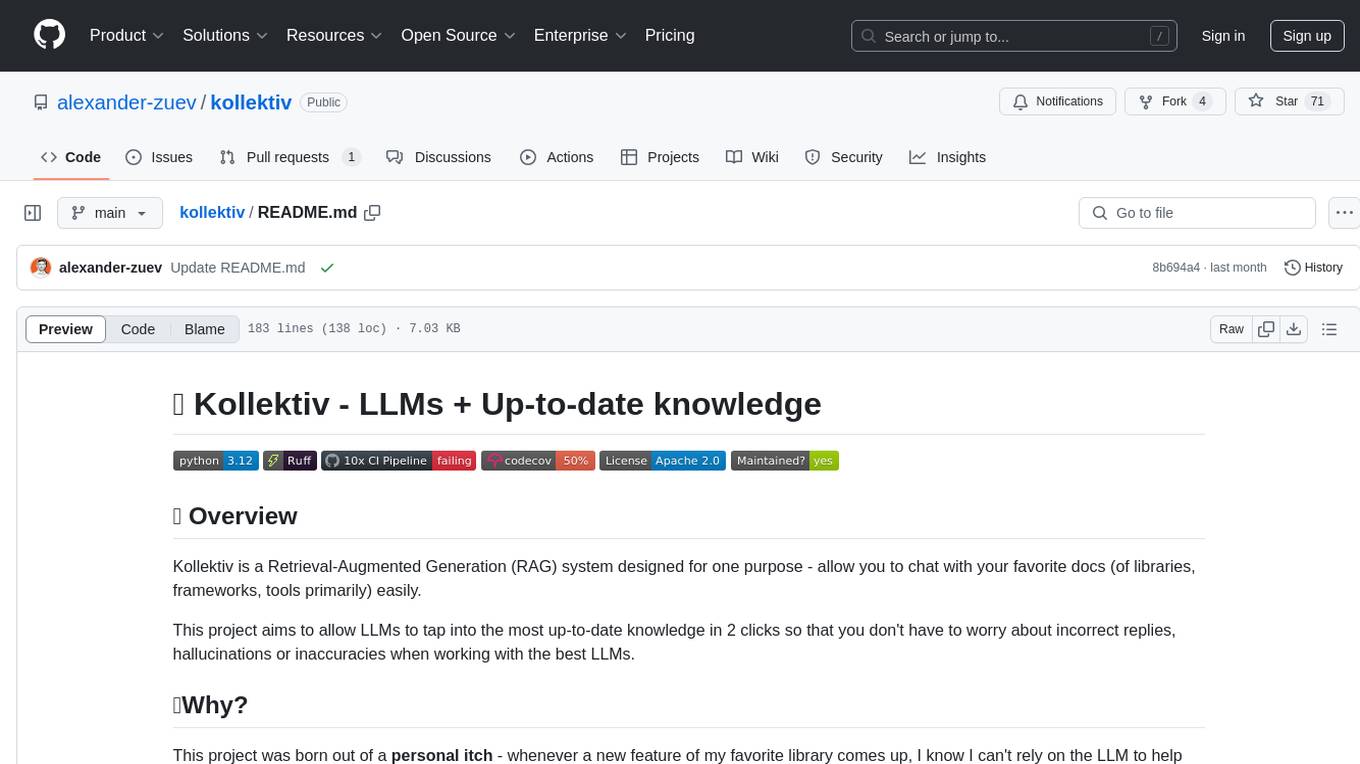
kollektiv
Kollektiv is a Retrieval-Augmented Generation (RAG) system designed to enable users to chat with their favorite documentation easily. It aims to provide LLMs with access to the most up-to-date knowledge, reducing inaccuracies and improving productivity. The system utilizes intelligent web crawling, advanced document processing, vector search, multi-query expansion, smart re-ranking, AI-powered responses, and dynamic system prompts. The technical stack includes Python/FastAPI for backend, Supabase, ChromaDB, and Redis for storage, OpenAI and Anthropic Claude 3.5 Sonnet for AI/ML, and Chainlit for UI. Kollektiv is licensed under a modified version of the Apache License 2.0, allowing free use for non-commercial purposes.
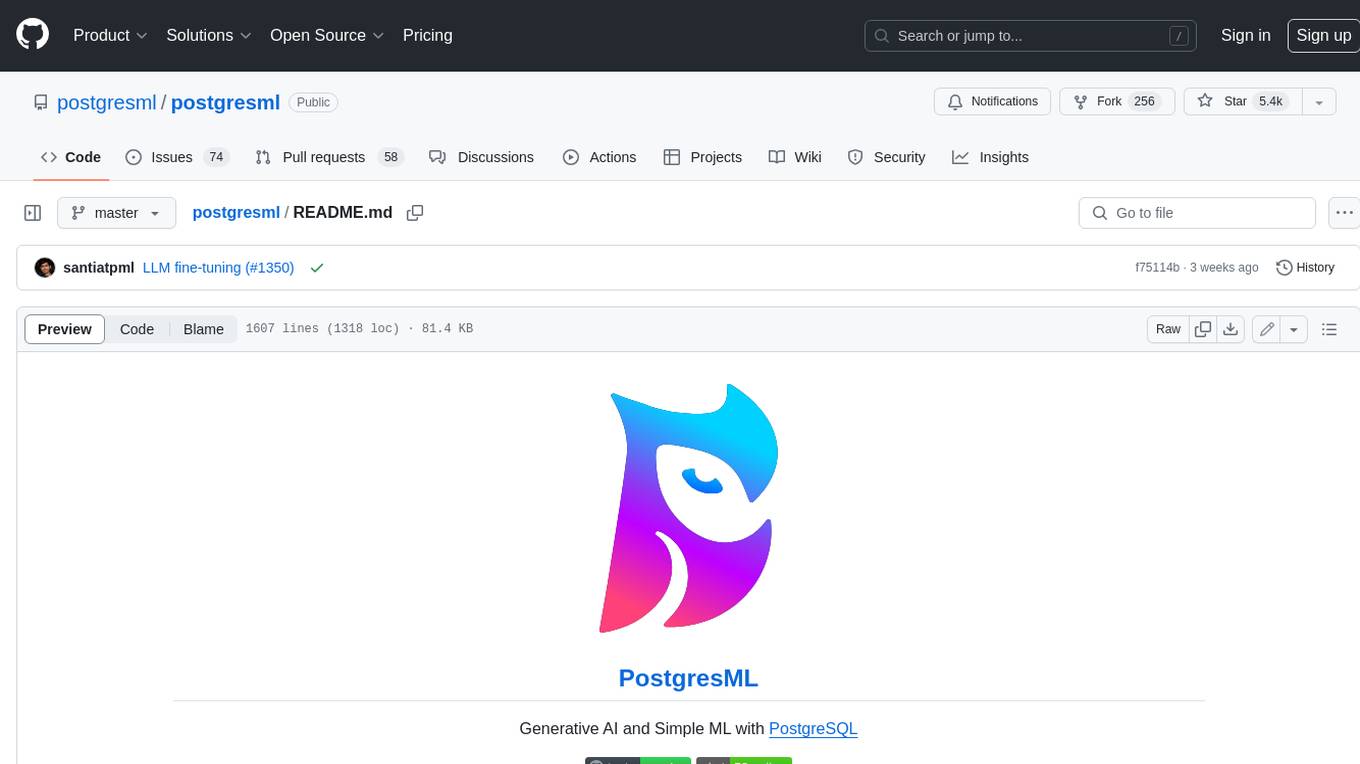
postgresml
PostgresML is a powerful Postgres extension that seamlessly combines data storage and machine learning inference within your database. It enables running machine learning and AI operations directly within PostgreSQL, leveraging GPU acceleration for faster computations, integrating state-of-the-art large language models, providing built-in functions for text processing, enabling efficient similarity search, offering diverse ML algorithms, ensuring high performance, scalability, and security, supporting a wide range of NLP tasks, and seamlessly integrating with existing PostgreSQL tools and client libraries.
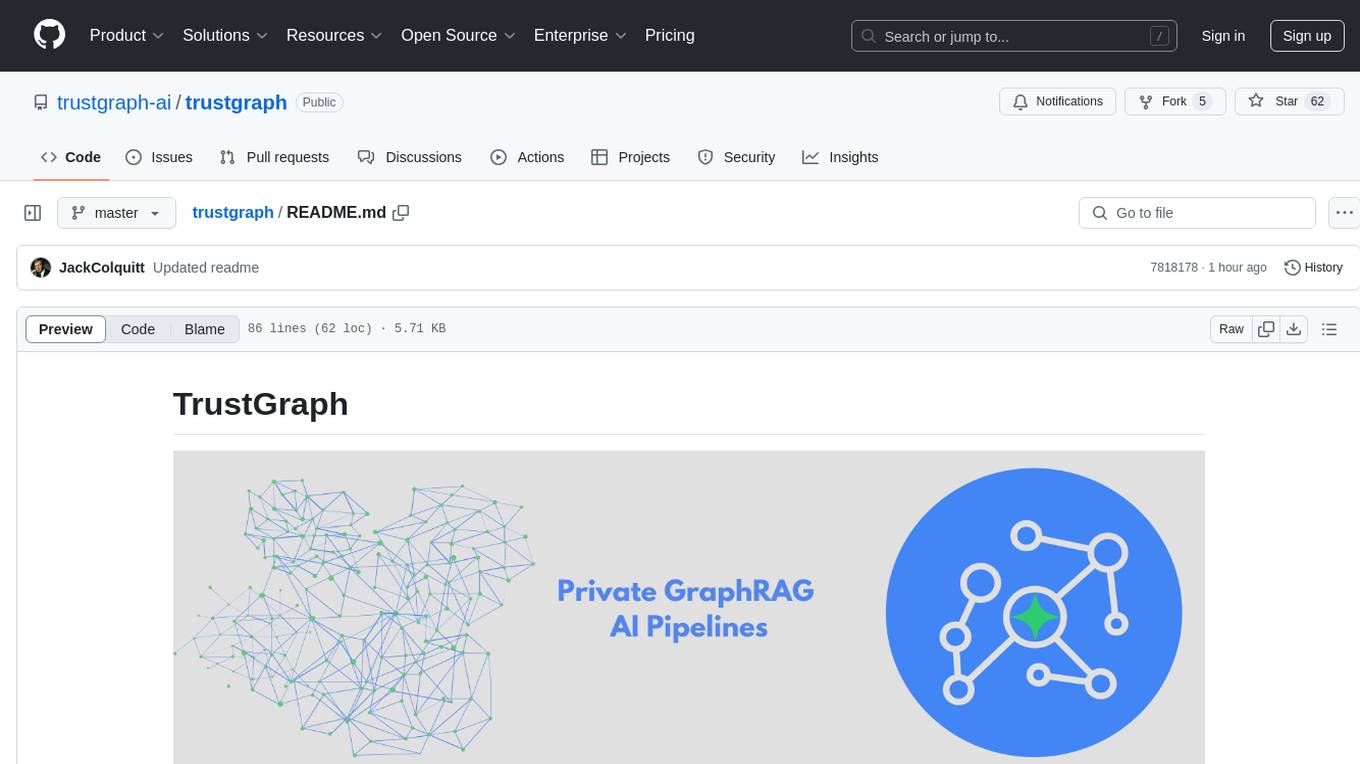
trustgraph
TrustGraph is a tool that deploys private GraphRAG pipelines to build a RDF style knowledge graph from data, enabling accurate and secure `RAG` requests compatible with cloud LLMs and open-source SLMs. It showcases the reliability and efficiencies of GraphRAG algorithms, capturing contextual language flags missed in conventional RAG approaches. The tool offers features like PDF decoding, text chunking, inference of various LMs, RDF-aligned Knowledge Graph extraction, and more. TrustGraph is designed to be modular, supporting multiple Language Models and environments, with a plug'n'play architecture for easy customization.
For similar tasks

partcad
PartCAD is a tool for documenting manufacturable physical products, providing tools to maintain product information and streamline workflows at all product lifecycle phases. It is a next-generation CAD tool that focuses on specifying manufacturable physical products using computer-aided design in a more generic sense, including the use of AI models. PartCAD offers modular and reusable packages for product information, generating outputs like product documentation, bill of materials, sourcing information, and manufacturing process specifications. It integrates with third-party tools for iterative improvements, design validation, and manufacturing processes verification. PartCAD also offers supplementary products like a CRM and inventory tool for managing part manufacturing and assembly shops. By enabling easy switching between third-party tools, PartCAD creates a competitive environment for service providers and ensures data sovereignty for users.
For similar jobs
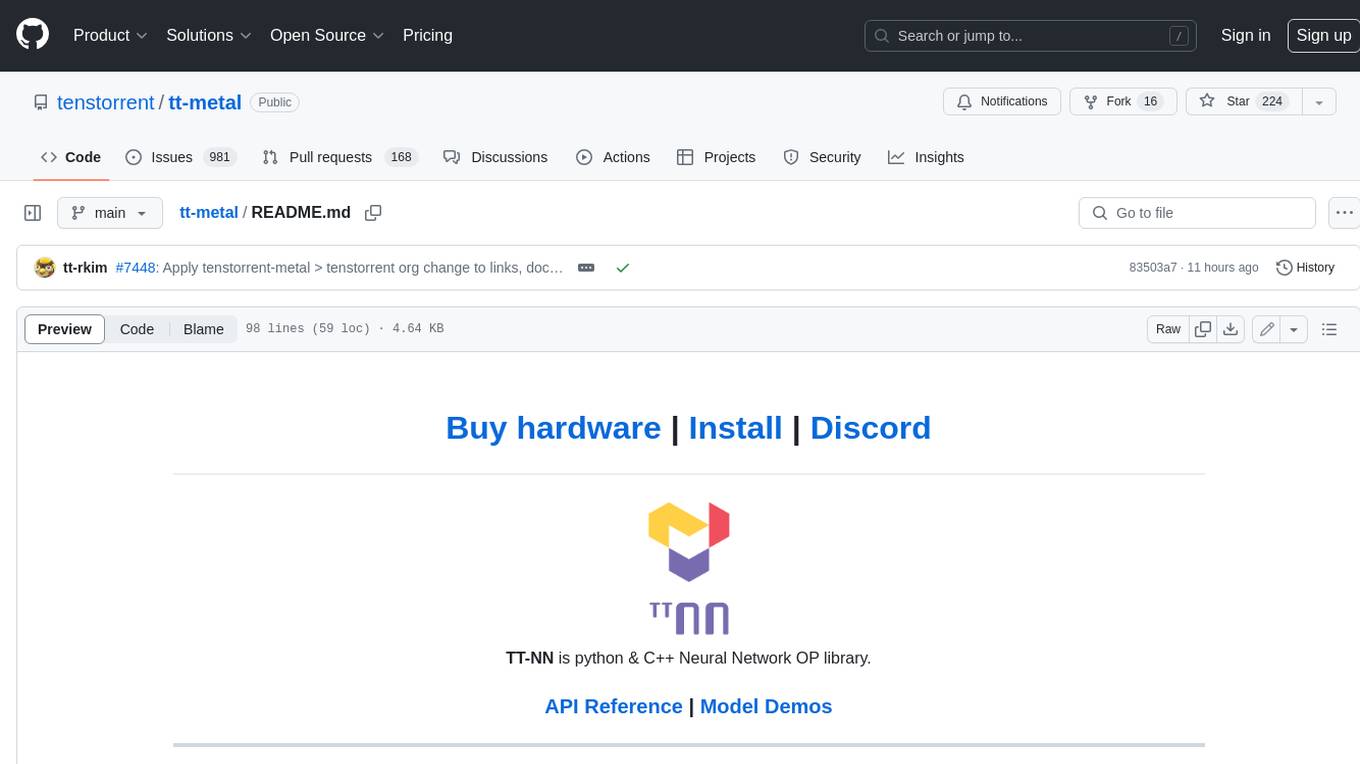
tt-metal
TT-NN is a python & C++ Neural Network OP library. It provides a low-level programming model, TT-Metalium, enabling kernel development for Tenstorrent hardware.
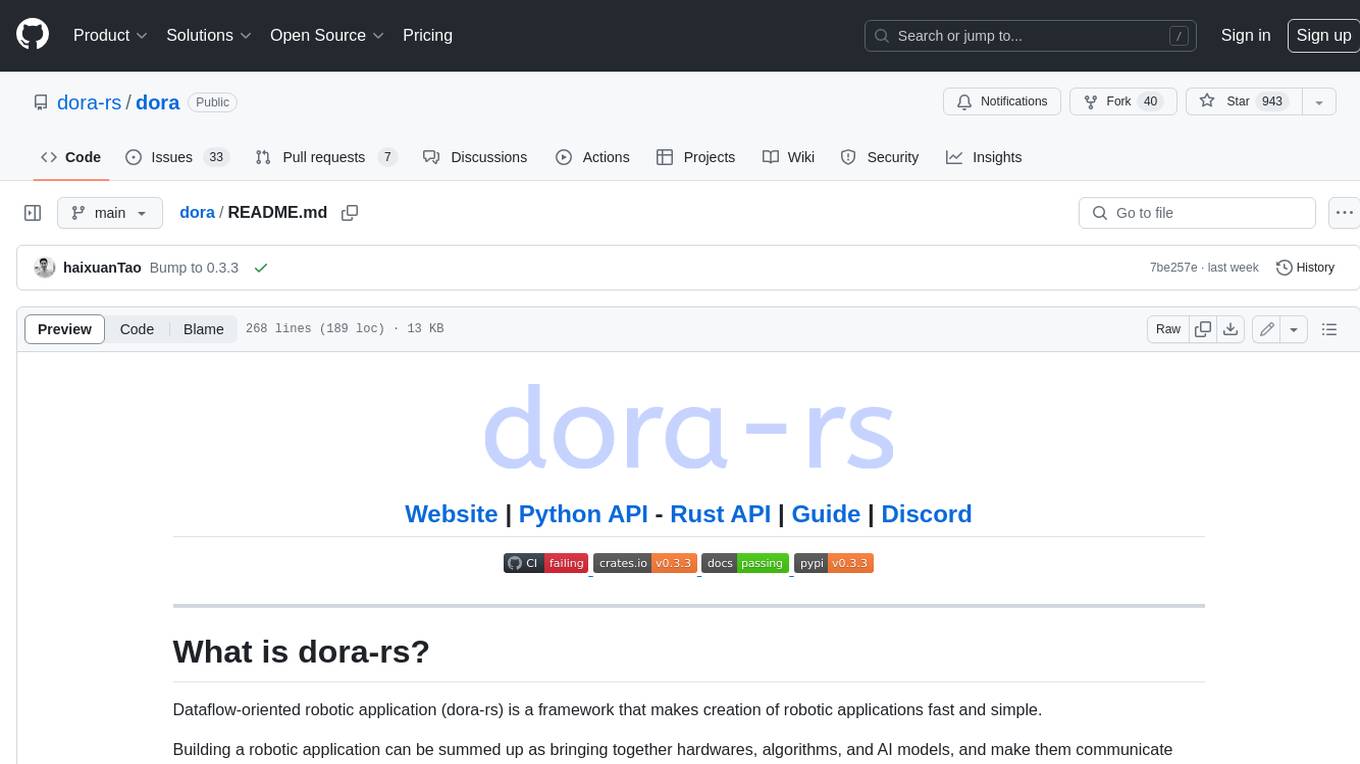
dora
Dataflow-oriented robotic application (dora-rs) is a framework that makes creation of robotic applications fast and simple. Building a robotic application can be summed up as bringing together hardwares, algorithms, and AI models, and make them communicate with each others. At dora-rs, we try to: make integration of hardware and software easy by supporting Python, C, C++, and also ROS2. make communication low latency by using zero-copy Arrow messages. dora-rs is still experimental and you might experience bugs, but we're working very hard to make it stable as possible.
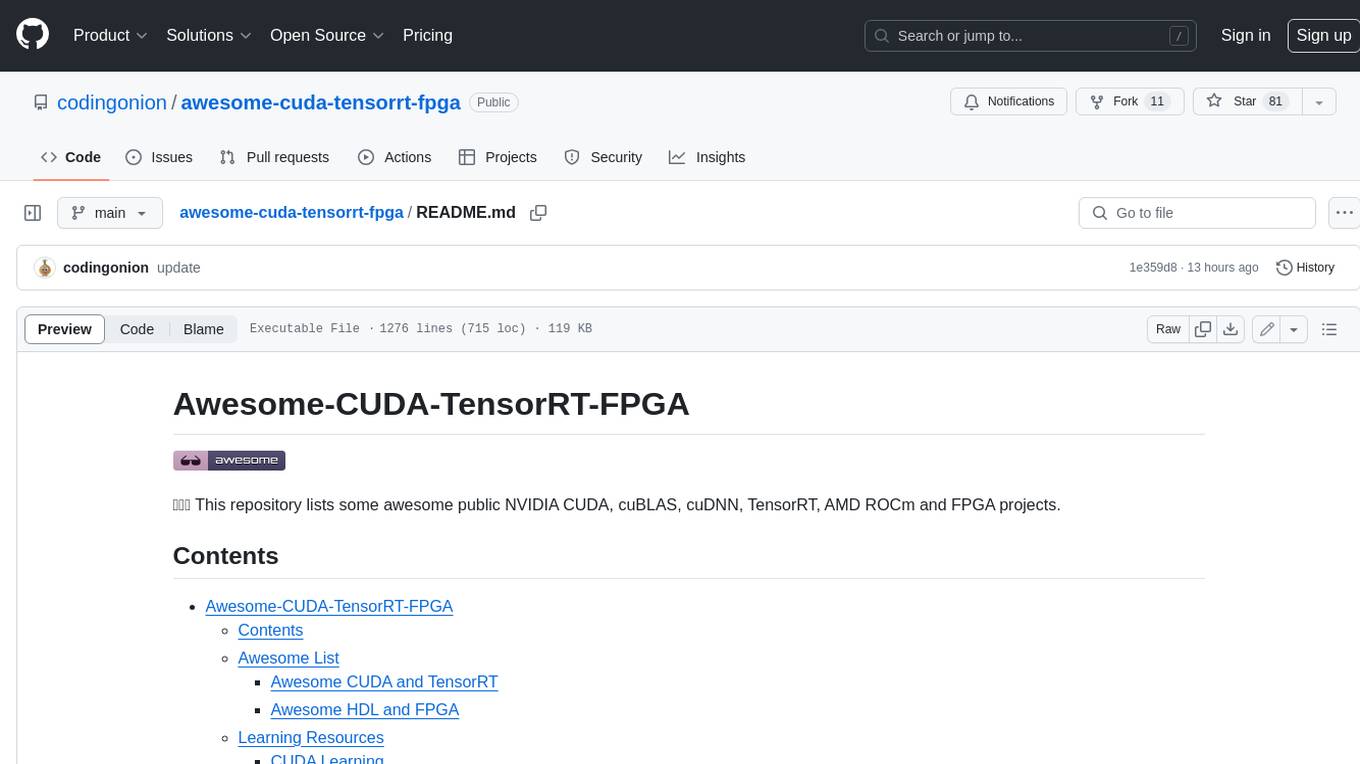
awesome-cuda-tensorrt-fpga
Okay, here is a JSON object with the requested information about the awesome-cuda-tensorrt-fpga repository:
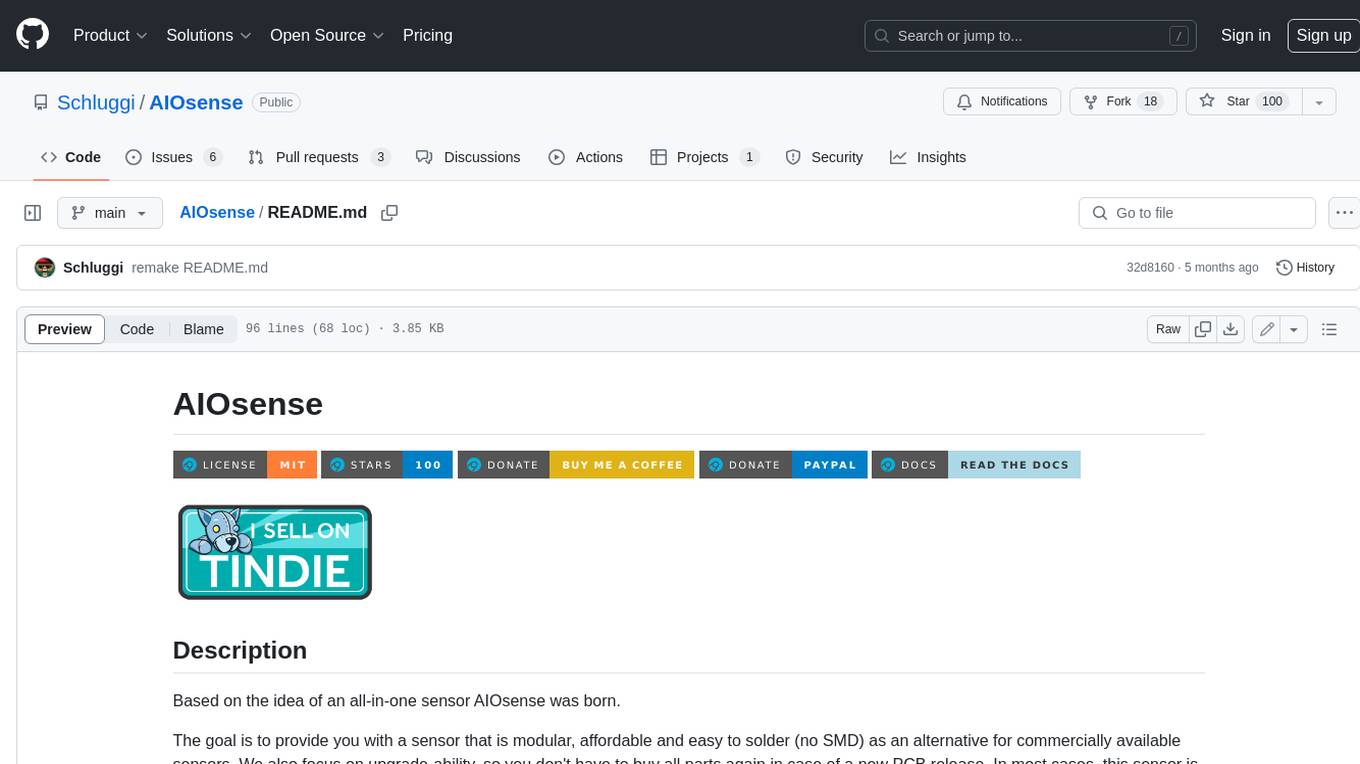
AIOsense
AIOsense is an all-in-one sensor that is modular, affordable, and easy to solder. It is designed to be an alternative to commercially available sensors and focuses on upgradeability. AIOsense is cheaper and better than most commercial sensors and supports a variety of sensors and modules, including: - (RGB)-LED - Barometer - Breath VOC equivalent - Buzzer / Beeper - CO² equivalent - Humidity sensor - Light / Illumination sensor - PIR motion sensor - Temperature sensor - mmWave / Radar sensor Upcoming features include full voice assistant support, microphone, and speaker. All supported sensors & modules are listed in the documentation. AIOsense has a low power consumption, with an idle power consumption of 0.45W / 0.09A on a fully equipped board. Without a mmWave sensor, the idle power consumption is around 0.11W / 0.02A. To get started with AIOsense, you can refer to the documentation. If you have any questions, you can open an issue.
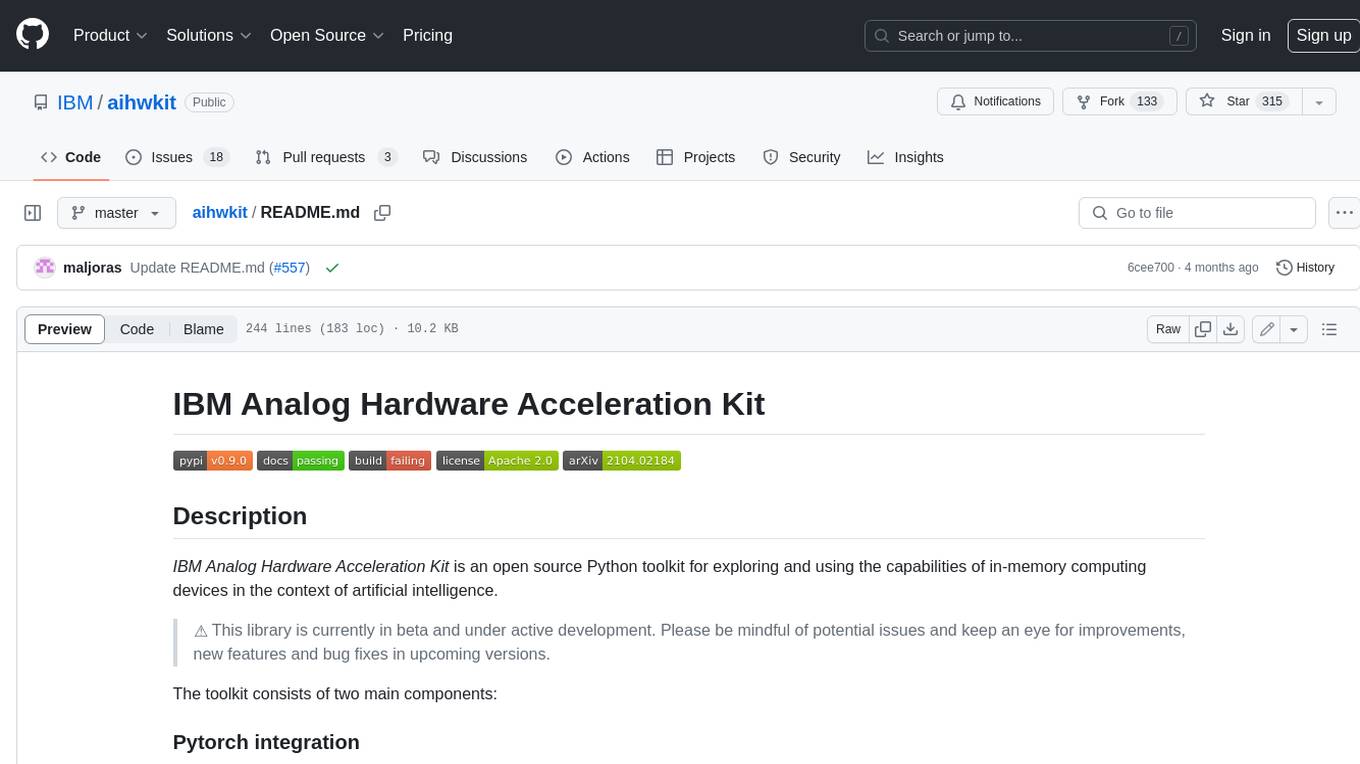
aihwkit
The IBM Analog Hardware Acceleration Kit is an open-source Python toolkit for exploring and using the capabilities of in-memory computing devices in the context of artificial intelligence. It consists of two main components: Pytorch integration and Analog devices simulator. The Pytorch integration provides a series of primitives and features that allow using the toolkit within PyTorch, including analog neural network modules, analog training using torch training workflow, and analog inference using torch inference workflow. The Analog devices simulator is a high-performant (CUDA-capable) C++ simulator that allows for simulating a wide range of analog devices and crossbar configurations by using abstract functional models of material characteristics with adjustable parameters. Along with the two main components, the toolkit includes other functionalities such as a library of device presets, a module for executing high-level use cases, a utility to automatically convert a downloaded model to its equivalent Analog model, and integration with the AIHW Composer platform. The toolkit is currently in beta and under active development, and users are advised to be mindful of potential issues and keep an eye for improvements, new features, and bug fixes in upcoming versions.
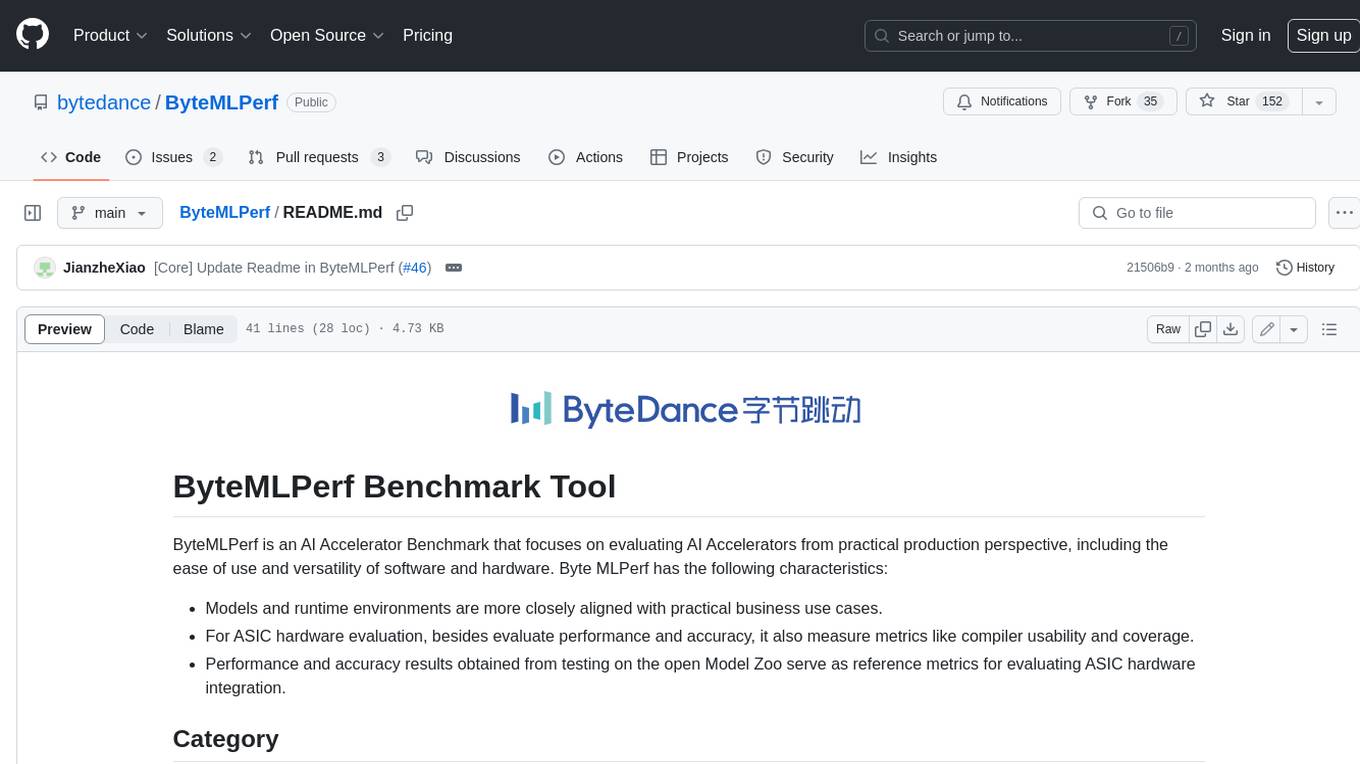
ByteMLPerf
ByteMLPerf is an AI Accelerator Benchmark that focuses on evaluating AI Accelerators from a practical production perspective, including the ease of use and versatility of software and hardware. Byte MLPerf has the following characteristics: - Models and runtime environments are more closely aligned with practical business use cases. - For ASIC hardware evaluation, besides evaluate performance and accuracy, it also measure metrics like compiler usability and coverage. - Performance and accuracy results obtained from testing on the open Model Zoo serve as reference metrics for evaluating ASIC hardware integration.

GlaDOS
This project aims to create a real-life version of GLaDOS, an aware, interactive, and embodied AI entity. It involves training a voice generator, developing a 'Personality Core,' implementing a memory system, providing vision capabilities, creating 3D-printable parts, and designing an animatronics system. The software architecture focuses on low-latency voice interactions, utilizing a circular buffer for data recording, text streaming for quick transcription, and a text-to-speech system. The project also emphasizes minimal dependencies for running on constrained hardware. The hardware system includes servo- and stepper-motors, 3D-printable parts for GLaDOS's body, animations for expression, and a vision system for tracking and interaction. Installation instructions cover setting up the TTS engine, required Python packages, compiling llama.cpp, installing an inference backend, and voice recognition setup. GLaDOS can be run using 'python glados.py' and tested using 'demo.ipynb'.

OpenGlass
OpenGlass is an open-source project that allows users to transform any regular glasses into smart glasses using affordable off-the-shelf components. With a cost of less than $25, users can enhance their glasses to record their daily activities, recognize people, identify objects, translate text, and more. The project provides detailed instructions on hardware setup and software installation, making it accessible for DIY enthusiasts and tech enthusiasts alike. By following the steps outlined in the repository, users can create their own smart glasses and explore various functionalities offered by the project.

